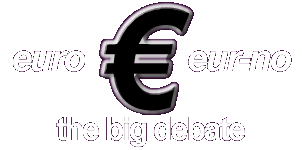
The average sized town between London and Brighton on the A272 |
|
current location: archive - the euro debate |
| In
March 2002 we reported on the introduction of the Euro in many of
Britain's european partner nations.
On January 1 2002, Euro banknotes and coins were introduced in the 12 eurozone countries, Austria, Belgium, Finland, France, Germany, Greece, Holland, Ireland, Italy, Luxembourg, Portugal and Spain. This landmark change in Europe's financial landscape has prompted much debate and in this special feature we attempt to answer several key questions and try to explain how the Euro will affect Haywards Heath. Question: Is there much substance to the argument that the introduction of the Single European Currency, and with it the submission of control over the instruments of monetary and fiscal policy to the European central bank, will marginalise certain participating European economies paradoxically leading to regional variations in the effectiveness of what is intended to be a pan-European economic policy designed to enhance the economic prosperity of the region as a whole? Answer: Well......it's horses for courses really.
Question: Does Haywards Heath accept the Euro? Answer: NO. Haywards Heath has yet to enter the eurozone. In the event that Britain does adopt the Euro Haywards Heath will likely remain in its own Sterling zone or indeed break away from the Union altogether so as not to be overrun by roaming gangs of national stereotypes from the continent. While the pound would remain, the image of the Queen would likely be replaced by our local MP, Nicholas Soames on all but the £50 note.
Question: But I've heard that some shops in London accept the Euro, are there no shops in Haywards Heath that duplicate this practice? Answer: Though we haven't checked the answer is NO. You may also have problems spending Scottish money and any issues of the £1 coin featuring Welsh iconography (dragon,leek, Shirley Bassey).
Question: I live in Haywards Heath, how do I know if a rogue tourist is trying to palm me off with a handful of dodgy Euro bank notes. Answer: They'll most likely speak with an accent for a start but to help you identify the new Euro notes the table below gives a description including the architectural style represented by each denomination. Clicking on the denomination will show a picture of the notes all of which were designed by Robert Kalina, an Austrian artist representing the Oesterreichische Nationalbank who in December 1996 won the competition set by the Council of the European Monetary Institute (EMI) to design euro banknotes. By the way, if you're a taxi driver in Haywards Heath you need not worry since you rarely accept high denomination notes anyway.
Question: Is there any
way I can use the Euro to my advantage?
Answer: Certainly. Having a selection of Euros in your wallet and 'accidentally' trying to pay for things with them will lead people to believe you regularly travel in the eurozone either on holiday or for business purposes. They also serve as a interesting conversation piece at dinner parties or the golf club where we advise you to use phrases such as 'Mickey Mouse money', 'Monopoly money', 'toytown money' and 'eurocrat'. You could also use the discussion as an opportunity to accuse the French of 'collaborating with the Germans just like they did in the war' but in the same breath extolling the virtues of a weeks holiday in a Provencal gîte.
So to recap. Haywards Heath does not accept the Euro.
If you care, the table below has details about what the Euro coins look like.
|
|
|||||||||||||||||||||||||||||||||||||||||||||||||||||||||||||||||||||||||||||
© thisishaywardsheath.com entertainments limited. thisishaywardsheath.com and 'the average sized town between london and brighton on the A272' are trademarks of thisishaywardsheath.com global marketing limited. thisishaywardsheath.com global marketing limited and thisishaywardsheath.com entertainments limited are part of the thisishaywardsheath.com holding (bermuda) limited group. complicated isn't it. |
